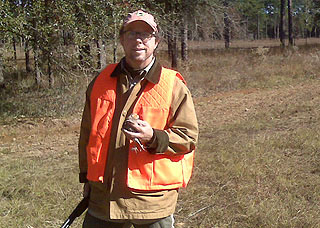It takes a crew of folks to quail hunt. At least at Gillionville Plantation, it does. Although the trappings of the place are Old South—columned main house, white-jacketed waiters—the popularity of posh quail hunting down here in Georgia escalated after the Civil War, as northern industrialists came South, seeking a purchase on the so-called good life, buying up land for leisure.

My first bird. Photo: Ben Pitts.
Some quail hunting plantations now take their guests out on four-wheelers. And they hunt farm-raised birds. But Gillionville does it the traditional way. That means wild birds. And that means we work the fields in teams of four, with two of us on horseback and two on the mule-drawn wagon. (After a good kill or a sufficient passage of time, we switch off.) Our support staff includes a mule driver, a brace of bird dogs who yelp and pant in the back of the wagon, a guide who follows the dogs on horseback as they scent and point, and a second guide who beats the bushes with a leather strop if the quail fail to flee upon our approach.
I need all the support I can get, I tell myself as I dismount from my horse and chamber two shells. After an hour of tramping about, I've shot and missed four times.
A covey bursts from a patch of dog fennel. I site and squeeze. And a brown and feathery blur arcs downward into a thicket. We find the quail in a pile of pine straw, right wing clipped, both eyes blood-rimmed. I'm momentarily saddened. And exhilarated.
The night before, we ate quail for dinner. Partially deboned, stuffed with ratatouille, the plate ringed with a molasses sauce, it was flat-out delicious. In the moments after that first kill, my mind races, processing all manner of moral and sensual inputs. But I keep returning to a series of linked questions: Will we be eating quail for breakfast? And if so, will that mean smothered quail on a bed of stone-ground grits? Or battered and fried quail with scrambled eggs?

